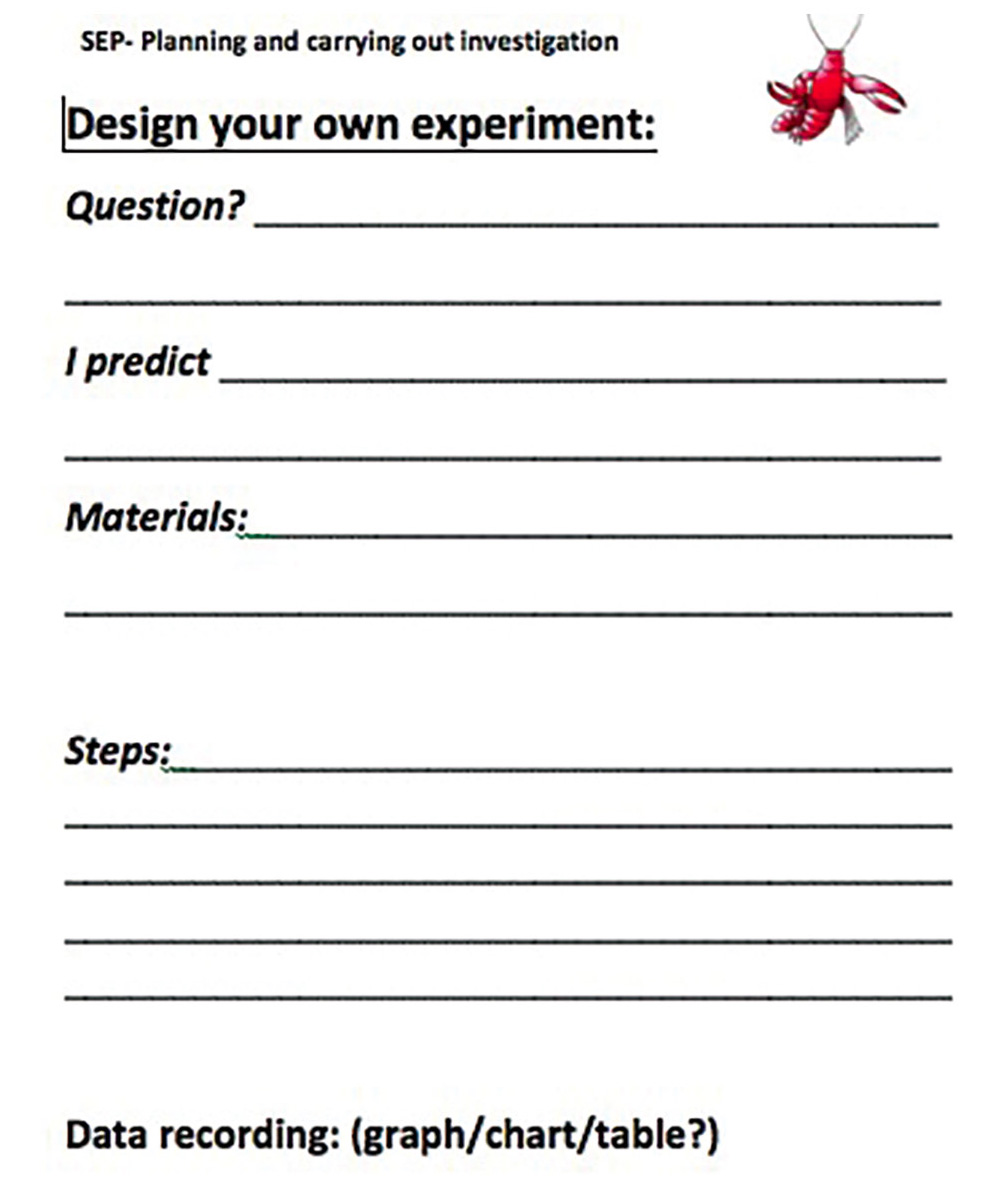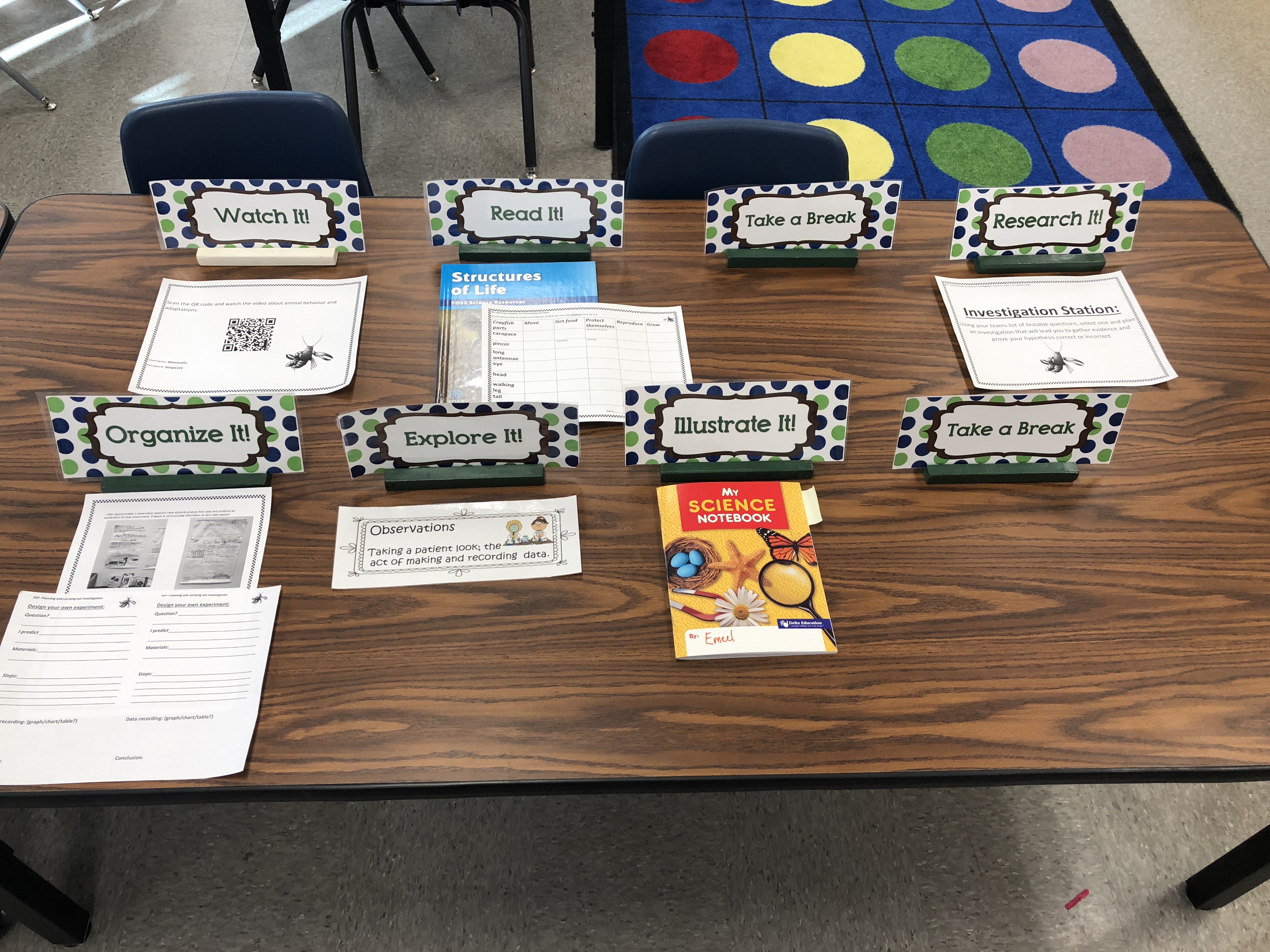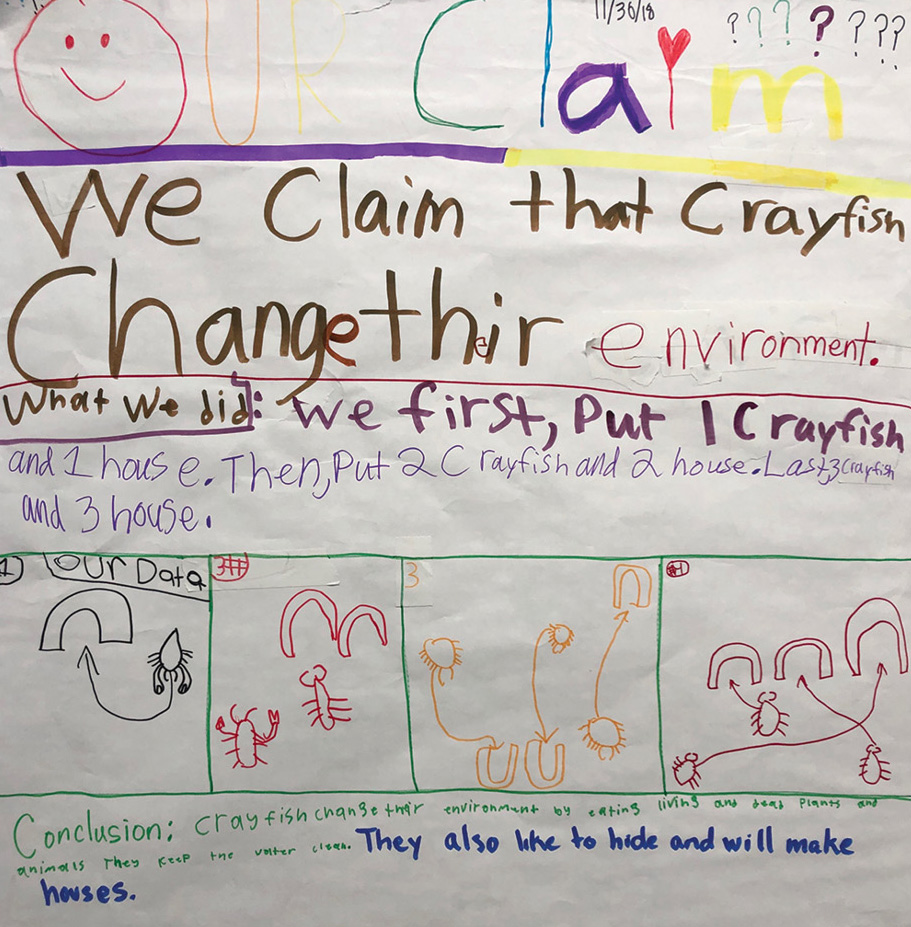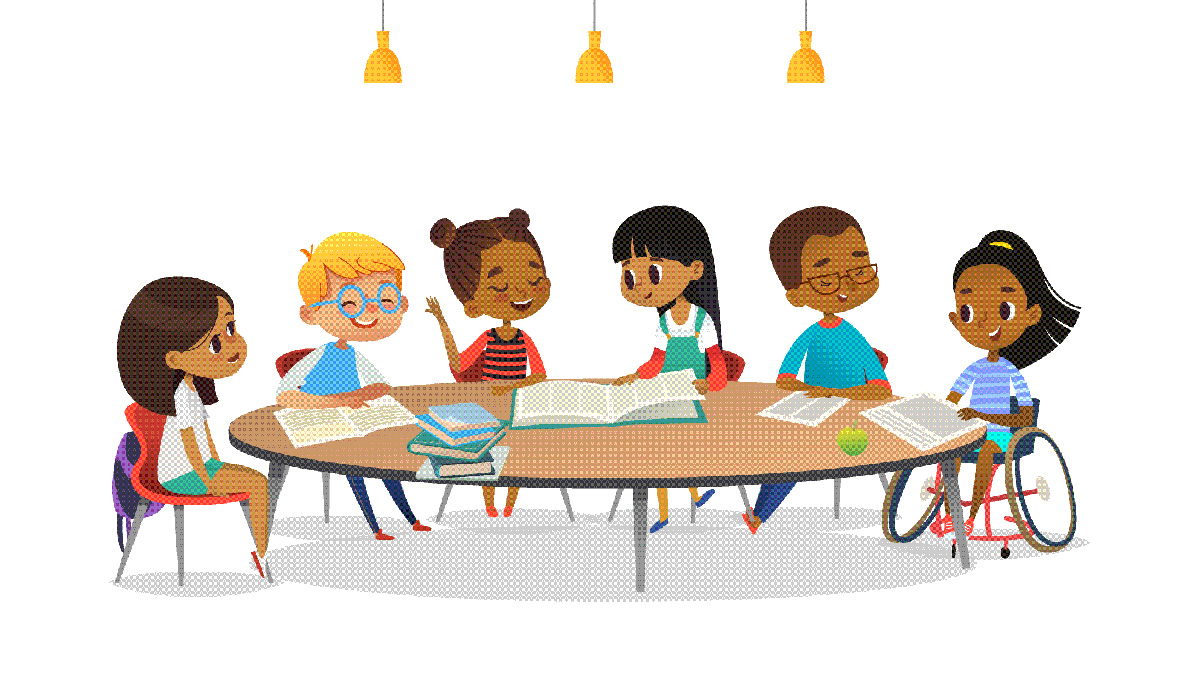feature
Let's Give Them Something to Talk About
Designing lessons that cultivate productive discourse for three-dimensional learning in the intermediate science classroom.
Students in the intermediate grades love to talk—but not necessarily about making sense of what they are learning. How do we design classrooms that cultivate productive discourse? How do we get out of the way and teach children to learn? First, let’s give them something to talk about. Second, we need to teach them how to engage in productive discourse so their thinking can be the priority. Finally, when we understand the three dimensions of the standards we are teaching, we can effectively draw them out in student thinking. Although I had taught third-grade life science using crayfish for several years, I hadn’t been confident in the knowledge of how to teach three-dimensionally and use accountable talk until recently. I finally felt ready to step back and help my students truly experience what being a scientist meant. I used the 5E Instructional Model (Engage, Explore, Explain, Elaborate, Evaluate) because it promotes active, collaborative learning and it is perfect for an inquiry-based science classroom. Through this unit students recorded structures and observed behaviors through direct interaction with live crayfish to construct an explanation using evidence for how variations in characteristics among individuals of the same species may provide advantages in surviving, finding mates, and reproducing. It was my focus on the discourse that unlocked the learning for all students and made this unit so successful.
Getting Started
First things first ... crayfish in the classroom? The answer is YES! It’s easier than you think. You can order classroom critters from Carolina Biological Supply or, if you use the Full Option Science System or (FOSS) curriculum, you can order from Delta Education. Students love working with live animals in the classroom, feeding them, and taking care of them. I purchased a fish tank filter and used an old kindergarten water table for our classroom crayfish habitat. I then demonstrated how to pick up the crayfish safely. As with all living organisms we work with, we discussed how to treat them with gentle hands and with respect. Madagascar Hissing cockroaches are perfect substitutes for crayfish if you have a student with an airborne shellfish allergy, or if the use of crayfish is restricted in your state.


Engage (1–2 sessions)
After I introduced the crayfish (and lots of excited squeals), students brainstormed their own questions to explore. I wanted to capitalize on all the natural conversation that was happening and focus it. I divided the class into heterogeneous teams of four. Together, the teams brainstormed questions about the crayfish; these became their personal phenomena. Next time, I will give each member of the team a different color marker and require that their phenomena posters have all four colors on it to ensure equitable participation of each team member.
During this session, students were reminded of some conversation sentence stems to use. One way I addressed this was in the use of sentence strips with the conversation prompts on them (Figure 1). The strips were displayed in pocket charts so that I could encourage student use by handing them out or putting them on tables during the lesson and remind students of the discourse format. This “science talk” was embedded in every lesson and helped students to be accountable for their own learning.

Knowing that “knowledge-level” questions would be answered through research, I created a class question chart, so that I could strategically target specific student conversations to drive the thinking of the entire class. I said, “Here are some questions that different teams have been wondering about….” Then I would slip in some questions that came directly from the Next Generation Science Standards (NGSS) performance expectations (PEs) that groups may have been missing. I stretched their thinking by eliciting deeper questions that could relate to the PE. For example, when a group wondered if crayfish had teeth, I helped students to stretch their thinking into a bigger testable question such as, “How do crayfish eat?” or, “How do the crayfish change their environment?” After the brainstorming session, we discussed how scientists conduct research. I led students to see the difference between reading someone else’s research and having the kind of question you can actually test yourself. Next, the teams evaluated their questions and labeled the testable ones. Then, each team selected the testable question that they would investigate. I encouraged them to investigate something different from the other groups in the room for a jigsaw effect at the final presentation. Two examples of student-generated questions are: “How do crayfish structures help them? Eat? Survive? Mate?” and “Why do crayfish fight?” We stopped early so we could all go wash our hands and wash the tables with soap and water after putting the crayfish back in their habitat.
Explore: (2–3 sessions, 50 min each)
I introduced six work stations and estimated that students would spend approximately 25 minutes at each (Table 1). At this stage, students were focusing on science practices of designing investigations, gathering data, and recording details. The key disciplinary core ideas were structure/function and traits in 3-LS4-2. Stations allowed for smaller groups as students designed and carried out their own investigations. It also promoted interdependency as teams worked through the other stations.
Students were used to completing investigations by following directions and filling in a premade lab form (Figure 2). Designing their own investigation was new and challenging. Using various talk moves such as, “Tell me more,” or “How could you find out?” I encouraged the students to think and solve their own problems. Student: “Look, that one lost his pincer! Why do they fight?” Teacher: “What could we do to find out?” Student: “We could put two of them together and watch them.” Teacher: “Okay, do you think it matters if we put two males together or two females?” Students: “I predict that two males will fight and a boy and a girl will try to make babies.” Teacher: “So let’s start by writing your hypothesis down in your notebook.”
| Table 1. Crayfish stations. | ||||||||||||||||||||||||||||
|---|---|---|---|---|---|---|---|---|---|---|---|---|---|---|---|---|---|---|---|---|---|---|---|---|---|---|---|---|
|

Kids were excited to come to class, they had a purpose and they were on task! All the learning was dependent upon them all working together as a team and TALKING. It was my role to help keep discussions moving as I circled the room. For my English Learners, I provided sentence frames for them to share their thinking and prompted students to use them when necessary, such as “Can you explain more?” or “What do you think?” I listened to students and adjusted questions depending on the discussion. I asked questions with a crosscutting concept such as “What is the function of the claw structure?” or “What patterns do you notice that tells you ...?”
We’d only just begun and I could tell already that this mode of learning was making an impact on the amount and quality of discourse. Students were independently using the sentence stems to engage other team members: Jose said to Carmen, who is extremely shy and quiet, “So, what do you think Carmen?”
Explain: (2–3 sessions)
These sessions focused on designing experiments and documenting results. Students had to decide if they were going to use a chart, graph, or pictures from their notebooks for this section. Attention to third-grade measurement and data standards was important at this stage as students not only collected raw data but also had to analyze it and communicate the result. Although the groups were heterogeneous, one group chose a very challenging question and yet another seemed to not have any leadership. So twice I led a brief whole-class investigation of one of the group’s questions at the start of a class session, which served as a model and provided the scaffolding needed. I began by writing one of their questions on the whiteboard. Then I asked for input about what we would have to do to answer it. Together we designed simple steps then decided on a way to manage and collect data. This gave struggling students a format to follow for their own investigation.
Teacher note for next time: For students to end up with quantitative data that can culminate in a graph, I need to do a better job of helping students design testable questions that can result in the collection of measurable data. This would also be a good opportunity to collaborate with the instructor of the math block and perhaps students could have created their charts/graphs in math class. This may have resulted in a higher quality of scientific practice.
In small groups, students were using the phrases that were taught to them such as, “I agree with you because …” (Michaels and O’Connor 2012, p. 17), then they used their notebooks or prior knowledge to defend their claims. Through discourse, this group of students discovered another resource that aided them ... just like scientists.
- “Crayfish use their pincers to eat.”
- “Well, I respectfully disagree with you because I think the pinchers are used to tear up or grab their food.”
- “If we can’t get them to eat more right now, how else can we find out or watch them eat?”
- “Can we use YouTube to see if we can get more information, like a video?”
- “... Ok, so it looks like they have tiny little hands by their mouth. Let’s not feed this one until tomorrow then put it in a clear tub and watch again to collect more data. Sara and I will examine the diagram in the book a bit closer.”
Some teams realized that they needed to conduct another round of experimentation in order to have more conclusive evidence. One group was trying to figure out if there were certain situations that would cause the crayfish to hold their front pincers up and stand in a defensive position. After they documented two tests, they jumped to a conclusion without enough evidence to back it up, which they discovered through conversation with each other. After modeling how to ask for elaborations or ask to see evidence, students began making requests of each other using phrases such as, “Tell me more” and “Can you show me your evidence for that statement?” The team eventually decided that they would need to recreate that result in order to back up their claim. Those crucial discoveries required additional time spent on this stage. The additional time resulted in an increase in their understanding and provided necessary evidence for groups to successfully “argue” or discuss their claim in the following stages. May I just add that the students had become very attached to their crayfish by this point and handled them with great respect and care. The motivation for learning was internal and safety protocols were now routine.

Elaborate (2 sessions)
We utilized one entire session for teams to create posters that stated their Claim, Evidence, and Reasoning (Figure 3). Continuing to use the “guide-on-the-side” practice, I focused on building opportunities for students to develop a deep, personal rationale for their claims. This dialogue within groups was important because they needed to communicate their reasoning to their partners in order to collaborate effectively and create one joint presentation. Students first used the data they had collected in their notebooks and then developed a claim that was related to their testable question. Students wrote their claim on the top of the poster, for example: “We claim that crayfish fight to defend themselves.” They followed with a display of their data, their conclusions and reasoning, and then presented to the class. This portion of the unit is important because it is where students design a constructive response to their testable question. I collected formative data at this stage to ensure that each group was able to sufficiently support their claim with their evidence and also to identify any misconceptions that students may have had.

The room was all abuzz, all students were participating, and the rigor was high. Rigor is much more than the level of difficulty of the content, it is a balancing act between difficulty level and challenging one’s self as a student. I wanted to see the young scientists stepping out of their comfort zone and working hard to accomplish the project. As scientists do, we shared our information in a sort of scientific convention. I designed a rubric using the Common Core Speaking and Listening Standards for the poster presentations. This completed rubric was valuable for the general education teacher as he/she used it for grades. I address how I used it in the last section: Assessment.
When presentations were completed, we gathered into a large circle around one of the group posters as the focal point with each scientist holding their notebook. We were setting up for a type of science seminar that we call a Sense-Making Circle. It is similar to the Science Talks that elementary teacher-researcher Karen Gallas (1995) proposed in her book Talking Their Way Into Science. (In a sense-making circle, students talk to each other. It is not a back and forth with the teacher. This allows me to focus on discourse and communication among students as well as deepening their understanding.) The students were familiar with this protocol. As we gathered, I purposefully positioned myself in the back. In order to have the maximum amount of engagement, I began by asking students to read the claim on one of the posters and pair share whether they agreed or disagreed and why. Then I asked if anyone would be brave enough to start our conversation and tell us what he or she thought of one of the claims. This was followed by several students either commenting with, “I agree with you because…” or “I respectfully disagree with you because …” When there was a lull, I redirected by proposing a disciplinary core idea such as, “Some animals form groups that help members survive. Do you have evidence that crayfish do that also?” Then I asked students to turn and talk. This ensured that all students were participating and thinking. When attention was back to the whole group, one student made the claim that crayfish form groups and said that he noticed that in the large habitat, several crayfish appeared to almost huddle together. Another student commented that several times she and her partner had found more than one crayfish together under a small house. The group members that explored the fighting phenomenon then introduced their evidence. Again, students were reminded to use various phrases such as, “So you are saying?” or “Can you tell me more?” The entire group agreed to conclude that crayfish form groups to protect themselves. Students cited evidence, asked for elaborations and clarifications, and extended their understanding in order to construct conceptual knowledge.
At this point it should be clear that a Sense-Making Circle is more than just sharing, it is a place where metacognition happens. It was really powerful when a student asked to make a change to a poster as soon as we were done, based on their deeper understanding. When explaining and supporting their thinking, students were encouraged to use their student notebooks for evidence. Finally, a reason to use our science notebooks for something other than documenting our work! Additionally, for my ELLs and shy students, it was a brilliant way to provide the scaffolding they need to participate on an equal level. Having the sentence stems on strips is handy, as I could literally hand them to students as support.
Evaluate
Teaching students to use accountable talk created teams that had a sort of built-in peer review system. Students were catching misconceptions and discovering important ideas well before I took any sort of grade. I created a class list with the science and engineering practices across the top. Using a clipboard, I walked the room and collected authentic performance assessment data. I was able to check off practices that they were becoming proficient in, for my own formative assessment information. It was during this time that by focusing on discourse the students were empowered to do the thinking in the classroom. Although the sense-making circle supports SL.3.1, I did not use it as a speaking and listening assessment piece but rather as a formative assessment opportunity and a chance for the design to push each student’s thinking further toward meeting our science performance expectations.
To assess three-dimensionally, the summative scoring was a combination of the group presentations and the end-of-unit assessment that came from my science curriculum.
Every week, the rumble in the hallway was full of wonder and excitement: “I’m going to look that up.” “Hey, have you ever eaten lobster?” “I wonder if you can eat crayfish?” “My mom is going to freak out when I tell her what we are doing in science!” Through student-generated phenomenon, I was able to get “buy-in” and give the students something to talk about. Furthermore, by focusing on discourse, I was able to get out of the way and let the students do the authentic scientific work. Today, students must spend more time talking and in the sense-making mode than ever before. Giving children the tools to have extensive, productive discourse will enable them to substantiate their claims with evidence whether it is science-centered, political in nature, or pleading their case with their parents as they get older. The science classroom should be full of reading, writing, doing, and...TALKING. ●
Online Resources
The Complete Guide to Setting Up Effective Science Stations
https://www.keslerscience.com/the-complete-guide-to-setting-up-effective-science-stations
Anne M. Craddock (Phillam@nv.ccsd.net) is an elementary science specialist for Clark County School District in Las Vegas, Nevada.
5E Crosscutting Concepts Disciplinary Core Ideas Interdisciplinary NGSS Performance Expectations Teaching Strategies Three-Dimensional Learning



